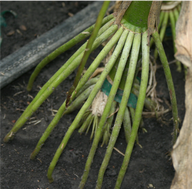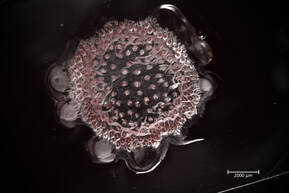Sparks Lab
Overview |
Brace roots develop in the air, and thus do not experience the same environmental signals as other root types. Our work in this area is divided into investigations of abiotic and biotic signals that may ultimately impact brace roots and/or plant biomechanics. In this project, we work with plant species outside of maize or sorghum to establish a baseline for future studies.
Current Funding
|
National Science Foundation (#1755355)
Delaware Space Grant NASA Seed Grant
|
National Aeronautics & Space Administration (#52650112)
University of Delaware Research Foundation - Strategic Initiative Fund
|
Prior Funding
|
Delaware Space Grant NASA Seed Grant
Delaware Biosciences Center for Advanced Technology
|
|
ABIOTIC ENVIRONMENTS
The impact of wind on plant biomechanics
In our projects related to brace root function we are using proxy measurements of plant biomechanics. However, we ultimately want to understand how these proxy measurements translate into plant interaction with the wind. Thus we are collaborating with a structural engineer, Dr. Monique Head, who specializes in the structural integrity of bridges. In this interdisciplinary collaboration, we are apply concepts from structural engineering to understand and predict crop failure under wind loads.
People working on this project: Jon Reneau
Collaborators: Dr. Monique Head
Collaborators: Dr. Monique Head
Light regulation of root development
The direct environmental cues that brace roots respond to is limited in the context of aerial formation. One major cue that may affect brace root development is the quality and intensity of light. However, there is limited knowledge about the light regulation of root development in any plant species. Thus, we have begun an investigation into this topic in the model plant Arabidopsis thaliana in collaboration with Dr. Ullas Pedmale. In this project, we are building a spatiotemporal root map in shade. The ultimate goal of this work is to translate knowledge from Arabidopsis thaliana into our understanding of brace root development.
People working on this project: Stephen Smith & Dr. Ashley Henderson
Collaborators: Dr. Ullas Pedmale
Collaborators: Dr. Ullas Pedmale
Root responses to a gravity continuum
Gravity is another environmental cue that brace roots respond to. There are two aspects of this area of research, first is the direct response of brace roots to stalk reorientation. It is known, but poorly documented, that after a stalk falls over brace roots will emerge from the stem nodes on the side closest to the ground. We are characterizing the dynamics of this process and the role of gravity to induce brace root development. In considering gravity as a continuum, we have also built a 2D clinostat that is capable of supporting plant growth to maturity. In this way, plants experience simulated microgravity through the randomization of the gravity vector. We are using this platform to analyze how different plants respond to simulated microgravity.
People working on this project: Stephen Smith & Jon Reneau
BIOTIC ENVIRONMENTS
Root-pathogen interactions under simulated microgravity
This project is a collaboration with Dr. Anjali Iyer-Pascuzzi in which the tools we have built are being leveraged to answer questions about plant-pathogen interactions under simulated microgravity. Specifically, we are investigating how tomato susceptibility to Fusarium oxysporum is altered by growth under simulated microgravity. This advances our understanding of plant-pathogen interactions in Space.
People working on this project: Stephen Smith & Jon Reneau
Collaborators: Dr. Anjali Iyer-Pascuzzi
Collaborators: Dr. Anjali Iyer-Pascuzzi
Root-pathogen interactions
Another project that has emerged from the tools we have built is a collaboration with UD Extension Plant Pathologist, Dr. Alyssa Koehler. In this project, we are working with a Delaware farmer to assess the impact of the root pathogen Pythium on maize root architecture and biomechanics.
People working on this project: Jon Reneau
Collaborators: Dr. Alyssa Koehler & Willin Farms, LLC
Collaborators: Dr. Alyssa Koehler & Willin Farms, LLC
|
Sparks Lab
University of Delaware |
Proudly powered by Weebly

